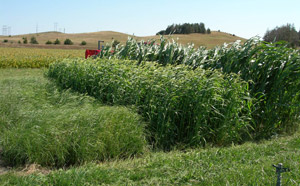Planted Forages as Options to Recovering Native Range
April 2016
 Recently, a range fire burned over 8,000 acres of native range in the Sandhills. Some producers may have access to pivots or other farming ground. Some of this ground may be planted to perennial forages, and traditionally used for hay; but could be grazed if another source of hay could be located. Some ground may typically be used for grain crops, but with commodity prices currently low, annual forages could be a viable option for integrated producers in need of summer forage.
Recently, a range fire burned over 8,000 acres of native range in the Sandhills. Some producers may have access to pivots or other farming ground. Some of this ground may be planted to perennial forages, and traditionally used for hay; but could be grazed if another source of hay could be located. Some ground may typically be used for grain crops, but with commodity prices currently low, annual forages could be a viable option for integrated producers in need of summer forage.
Planted forages can provide much needed deferment for recovering range. If planted forages are to be used for grazing, producers should consider dividing the pivot into paddocks and rotationally grazing the paddocks to improve forage utilization and to prevent overgrazing of the forage. Dr. Jerry Volesky, Range and Forage Specialist for UNL at West Central Research and Extension Center recommends dividing pastures into 5-6 paddocks and giving each paddock 28-35 days to recover after grazing. For more information about growing perennial forages see NebGuide G1502 Perennial Forages for Irrigated Pasture (PDF version 688KB).
Annual forages can be planted either under pivot or on dryland acres to stretch range resources. Planting cool season annuals in early spring, warm season annuals in May or June, and cool season annuals again in late summer can make a forage chain to supply forage most of the growing season. For more information on planting dates, seeding rates, and initiating grazing on annual forages see NebGuide G2185 Utilizing Annual Forages with Limited Irrigation for Beef Cattle During and Following Drought (PDF version 1.09MB).
Nitrates and prussic acid are typically not an issue when irrigation is available but can be more of a concern when forages are planted on dryland acres. There are several summer annual forages available for western Nebraska. These can provide high quality grazing when managed properly. For more information on summer annual forage production in western Nebraska see NebGuide G2172 Summer Annual Forages for Beef Cattle in Western Nebraska (PDF version 344KB).
For additional information or help grazing planted forages to provide recovery time for burned native range, contact a Nebraska Extension Educator or a Specialist.
Karla H. Jenkins
Cow/Calf, Range Management Specialist